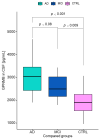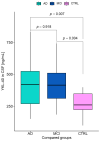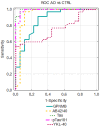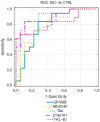Potential Utility of Cerebrospinal Fluid Glycoprotein Nonmetastatic Melanoma Protein B as a Neuroinflammatory Diagnostic Biomarker in Mild Cognitive Impairment and Alzheimer's Disease
- PMID: 37510803
- PMCID: PMC10380476
- DOI: 10.3390/jcm12144689
Potential Utility of Cerebrospinal Fluid Glycoprotein Nonmetastatic Melanoma Protein B as a Neuroinflammatory Diagnostic Biomarker in Mild Cognitive Impairment and Alzheimer's Disease
Abstract
Alzheimer's disease (AD) is a very common neurodegenerative disorder characterized by the gradual loss of neurons and extracellular amyloid-peptide buildup. There is compelling evidence that the disease process depends on neuroinflammatory alterations, such as the activation of astrocytes and microglia cells. A transmembrane glycoprotein known as glycoprotein nonmetastatic melanoma protein B (GPNMB) plays a neuroprotective role during the development of neurodegeneration. To the best of our knowledge, this is the first investigation discussing the potential clinical usefulness of this protein in the AD continuum, especially in the MCI (mild cognitive impairment) stage. A total of 71 patients with AD or MCI as well as controls were enrolled in this study. The concentrations of GPNMB, YKL-40, Aβ1-42 (amyloid beta 1-42), Tau, and pTau and the Aβ1-42/1-40 ratio in the CSF (cerebrospinal fluid) were tested using immunological methods. The concentrations of both GPNMB and YKL-40 in the cerebrospinal fluid were significantly higher in patients with AD and MCI compared to the controls. Moreover, both proteins were biochemically associated with classical biomarkers of AD and were especially associated with the Aβ1-42/1-40 ratio and Tau and pTau levels in the whole study group. Elevated concentrations of GPNMB were observed in the Aβ(+) group of AD patients compared to the Aβ(-) subjects. Additionally, the diagnostic performance (AUC value) of GPNMB was higher than that of amyloid β1-42 in MCI patients compared with controls. Our study indicates that GPNMB might be a promising neuroinflammatory biomarker for the early diagnosis and prognosis of the AD continuum, with potential utility as a therapeutic target.
Keywords: Alzheimer’s disease; GPNMB; YKL-40; neuroinflammation.
Conflict of interest statement
The authors declare no conflict of interest.
Figures





Similar articles
-
Evaluation of cerebrospinal fluid glycoprotein NMB (GPNMB) as a potential biomarker for Alzheimer's disease.Alzheimers Res Ther. 2021 May 4;13(1):94. doi: 10.1186/s13195-021-00828-1. Alzheimers Res Ther. 2021. PMID: 33947460 Free PMC article.
-
Glycoprotein NMB: a novel Alzheimer's disease associated marker expressed in a subset of activated microglia.Acta Neuropathol Commun. 2018 Oct 19;6(1):108. doi: 10.1186/s40478-018-0612-3. Acta Neuropathol Commun. 2018. PMID: 30340518 Free PMC article.
-
Glial activation and inflammation along the Alzheimer's disease continuum.J Neuroinflammation. 2019 Feb 21;16(1):46. doi: 10.1186/s12974-019-1399-2. J Neuroinflammation. 2019. PMID: 30791945 Free PMC article.
-
YKL-40 as a Potential Biomarker for the Differential Diagnosis of Alzheimer's Disease.Medicina (Kaunas). 2021 Dec 30;58(1):60. doi: 10.3390/medicina58010060. Medicina (Kaunas). 2021. PMID: 35056368 Free PMC article. Review.
-
Diagnostic function of the neuroinflammatory biomarker YKL-40 in Alzheimer's disease and other neurodegenerative diseases.Expert Rev Proteomics. 2017 Apr;14(4):285-299. doi: 10.1080/14789450.2017.1304217. Epub 2017 Mar 20. Expert Rev Proteomics. 2017. PMID: 28281838 Review.
Cited by
-
Early Detection of Alzheimer's Disease in Postmenopausal Women Using Thalamic Subnuclear Volumetry.J Clin Med. 2023 Oct 30;12(21):6844. doi: 10.3390/jcm12216844. J Clin Med. 2023. PMID: 37959308 Free PMC article.
-
CXCL14 in prostate cancer: complex interactions in the tumor microenvironment and future prospects.J Transl Med. 2025 Jan 4;23(1):9. doi: 10.1186/s12967-024-06022-9. J Transl Med. 2025. PMID: 39755616 Free PMC article. Review.
-
Overexpression of LINC00672 promotes autophagy in Alzheimer's disease by upregulating GPNMB.PLoS One. 2025 May 14;20(5):e0322708. doi: 10.1371/journal.pone.0322708. eCollection 2025. PLoS One. 2025. PMID: 40367036 Free PMC article.
-
Associations between Microglia and Astrocytic Proteins and Tau Biomarkers across the Continuum of Alzheimer's Disease.Int J Mol Sci. 2024 Jul 9;25(14):7543. doi: 10.3390/ijms25147543. Int J Mol Sci. 2024. PMID: 39062786 Free PMC article.
-
Plasticity of Human Microglia and Brain Perivascular Macrophages in Aging and Alzheimer's Disease.medRxiv [Preprint]. 2024 Dec 5:2023.10.25.23297558. doi: 10.1101/2023.10.25.23297558. medRxiv. 2024. PMID: 39677435 Free PMC article. Preprint.
References
-
- Alzheimer’s Association Alzheimer’s Facts and Figures Report|Alzheimer’s Association. Volume 1 Alzheimer’s Association; Chicago, IL, USA: 2021.
Grants and funding
LinkOut - more resources
Full Text Sources

